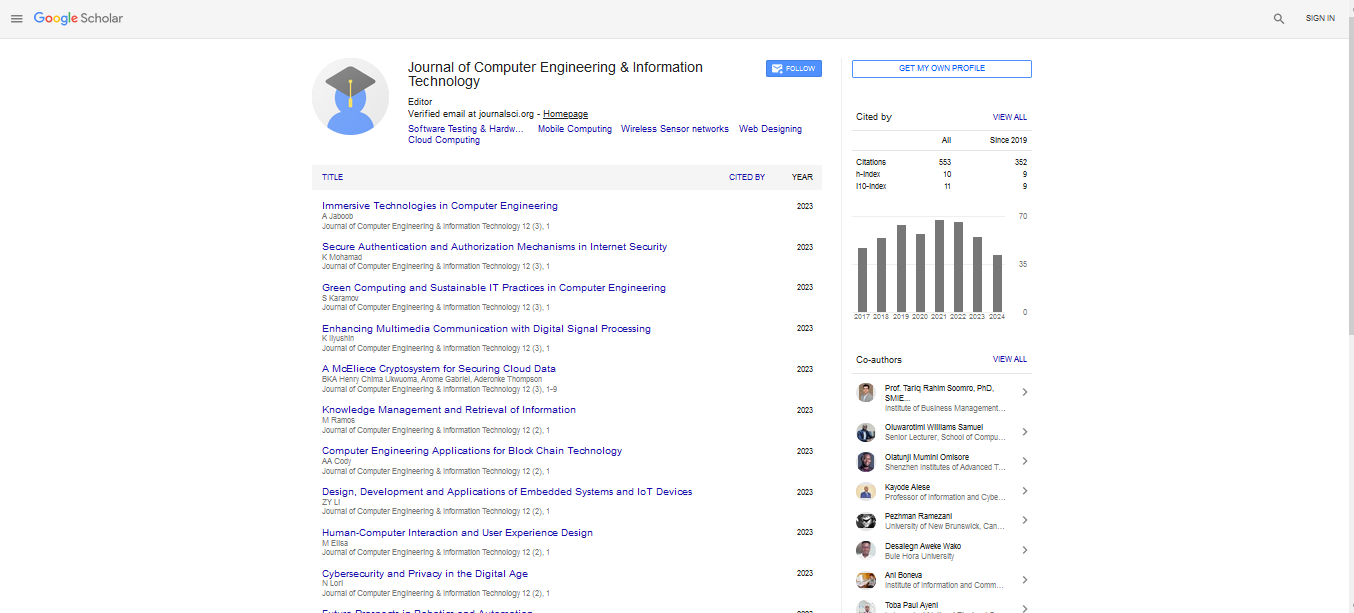Opinion Article, J Comput Eng Inf Technol Vol: 12 Issue: 1
Digital Innovations: Advances in Computer Engineering
Tuncay Cankaya*
Department of Computer Engineering, Suleyman Demirel University, Isparta, Turkey
*Corresponding Author: Tuncay Cankaya
Tuncay Cankaya, Department of Computer Engineering, Suleyman Demirel University, Isparta, Turkey;
E-mail: tuncay@can.edu.tr
Received date: 28 December, 2023, Manuscript No. JCEIT-23-95475;
Editor assigned date: 03 January, 2023, Pre QC No. JCEIT-23-95475 (PQ);
Reviewed date: 17 January, 2023, QC No JCEIT-23-95475;
Revised date: 24 January, 2023, Manuscript No. JCEIT-23-95475 (R);
Published date: 31 January, 2023, DOI: 10.4172/2324-9307.1000260
Citation: Cankaya T (2023) Digital Innovations and Advances in Computer Engineering. J Comput Eng Inf Technol 12:1.
Description
Computer engineering, a field at the intersection of computer science and electrical engineering, plays a pivotal role in shaping the modern digital landscape. It encompasses the design, development, and deployment of computer systems, networks, and software applications, and is instrumental in enabling the digital revolution that has transformed virtually every aspect of our lives.
Digital innovations have become the driving force behind the rapid progress and evolution of computer engineering. These innovations encompass a wide range of breakthrough technologies, techniques, and methodologies that are transforming the field and paving the way for new opportunities and applications.
One of the key areas of digital innovation in computer engineering is the advancement of microprocessors and integrated circuits. Moore's Law, which states that the number of transistors on a microchip doubles approximately every two years, has been a driving force behind the exponential growth of computing power. This has enabled the development of smaller, faster, and more powerful computer systems, from personal computers to data centers and cloud computing infrastructure. Advances in microprocessor technology have also fueled the proliferation of embedded systems and the Internet of Things (IoT), where computing capabilities are integrated into a wide range of devices and objects, such as smart appliances, wearables, and autonomous vehicles, among others.
Another significant area of digital innovation in computer engineering is the advancement of software technologies. This includes the development of programming languages, software frameworks, and algorithms that enable the creation of sophisticated and complex software applications. Innovations in software engineering have facilitated the development of a wide range of applications, from mobile apps to Artificial Intelligence (AI) and Machine Learning (ML) systems. These advancements have had a profound impact on various industries, including healthcare, finance, transportation, and entertainment, among others, and have transformed the way businesses and individuals interact with technology.
Advancements in networking and communication technologies have also been pivotal in driving digital innovations in computer engineering. The proliferation of high-speed internet, wireless communication, and 5G networks has revolutionized the way data is transmitted and shared, enabling new applications and services such as cloud computing, edge computing, and IoT. These advancements have transformed the way people communicate, collaborate, and access information, and have provided new opportunities for businesses and individuals alike.
In addition to hardware and software innovations, advances in data processing and analytics have also been important in driving digital innovations in computer engineering. The proliferation of big data and the development of advanced data analytics techniques, such as data mining, machine learning, and artificial intelligence, have enabled organizations to extract insights, make data-driven decisions, and create value from vast amounts of data. These advancements have been instrumental in various domains, including business intelligence, healthcare informatics, social media analysis, and scientific research, among others.
The rapid pace of digital innovations in computer engineering has also led to the emergence of interdisciplinary fields and cutting-edge research areas. For example, quantum computing, which leverages the principles of quantum mechanics to perform computations, has the potential to revolutionize computing by solving complex problems that are currently intractable for classical computers. Similarly, neuromorphic computing, which mimics the architecture and functionalities of the human brain, has the potential to provide new paradigms for computing and enable advanced AI and ML applications.
 Spanish
Spanish  Chinese
Chinese  Russian
Russian  German
German  French
French  Japanese
Japanese  Portuguese
Portuguese  Hindi
Hindi 